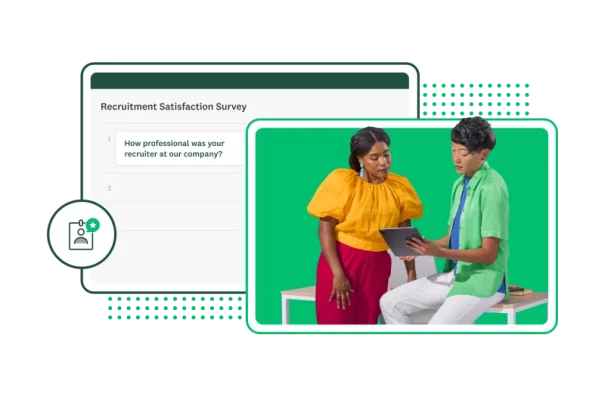Enhancing the employee lifecycle: 5 strategies for better EX
Enhance workforce management and engagement through our in-depth guide on the employee lifecycle.

Employees are the heart and soul of any organization. To keep things running smoothly, your business needs to ensure that your employees are happy, fulfilled, and satisfied throughout their entire tenure with your organization.
Businesses can track employee experience (EX) by measuring touchpoints at each stage of the employee lifecycle. Enhancing the employee lifecycle leads to better business and an improved workplace.
What is the employee lifecycle?
The employee lifecycle is a cycle of five stages representing an employee’s journey at your company: recruitment, onboarding, growth, retention, and offboarding.
Effectively managing the employee lifecycle is pivotal in enhancing the employee experience. Collecting data and turning it into actionable insights can help improve every area of EX, from recruitment to offboarding.
Related reading: HR quickstart guide: Employee surveys from hire to retire
The five stages of the employee lifecycle
Let’s explore each stage of the employee lifecycle and detail what you can expect in each:

1. Recruitment
The recruitment stage of the employee lifecycle involves finding, attracting, and hiring suitable candidates for a role. Employee touchpoints in this stage range from job advertisements to sharing your employee value proposition.
Companies want to make the recruitment process as easy as possible. Collecting data at this stage will help streamline the process. Companies can use key metrics to measure the recruitment phase of the employee lifecycle:
- Time-to-fill
- Cost-per-hire
- Time-to-productivity
This information empowers HR teams to identify weaknesses in their recruitment process and enhance their strategy.
Related reading: The recruiting manager toolkit
2. Onboarding
Once you’ve found the ideal candidate for a job, it’s time for them to move through your onboarding process. Employee onboarding teaches employees everything they need to know about their new role and your company culture.
Reviewing your onboarding process with employee feedback will help identify inconsistencies or difficulties. Alleviate these pain points to create a concise and effective employee onboarding.
Here are some common metrics to measure employee onboarding:
- Time-to-complete
- Time-to-productivity
- New hire employee turnover
Monitoring these employee onboarding metrics allows HR teams to assess the effectiveness of their onboarding processes and create a seamless experience for new employees. Since this is often a new employee's initial interaction with the company, a well-executed process can leave a positive impression.
Related reading: New hire onboarding survey
3. Growth
Employees working for your business should always have opportunities to grow their skills. You should offer professional training courses, paid courses, or similar development opportunities for ongoing learning.
Collecting information about the growth stage of an employee’s lifecycle will help your business determine if it's doing enough to support the upward trajectory of its workforce.
The most common metrics to measure an employee's growth phase include:
- Training participation rates
- Training completion rates
- Promotion rates
HR teams should pay close attention to the growth opportunities their organization presents to employees. Without offering growth opportunities, your employees may start disengaging from their work.
Related reading: Creating feedback-driven employee training
4. Retention
The retention phase is for experienced employees who have been with your company for a considerable time and have a comprehensive understanding of your organization's inner workings.
Employee engagement and job satisfaction surveys allow you to collect qualitative data on how these employees feel about your company. By gathering this data, you can identify strategies to close experience gaps, create a better work environment, and lower employee turnover.
Measure the retention phase of the employee lifecycle with these key metrics:
- Employee churn rate
- Engagement rate
- Job satisfaction
Organizations can use the insights from these metrics to create, track, and measure retention strategies that improve employee satisfaction.
Related reading: Job satisfaction: how to track (and why)
5. Offboarding
Offboarding is the final stage of the employee lifecycle, where the company bids farewell to an employee who has decided to leave.
This stage provides a valuable forum for discussing how your employees felt while with the company. Use exit interviews or exit interview surveys to facilitate the offboarding process.
These are the most common metrics to measure the offboarding phase of the employee lifecycle:
- Average employee lifespan
- Employee satisfaction
- Time-to-complete-offboarding
HR teams can use these metrics to collect information during the offboarding stage of the employee lifecycle. This data will help your teams improve areas employees felt frustrated with while at your business. Understanding why the company loses employees and the reasons behind that choice can go a long way toward beginning to fix those problems.
Related reading: Exit surveys: questions & templates

Why HR should understand the employee lifecycle
By understanding each stage of the employee lifecycle and what employees think or experience during that phase, your business can:
- Enhance employee retention: Happier employees will stay longer at your company. You’ll be able to retain top talent while decreasing expenditures on employee recruitment.
- Increase employee satisfaction: Listening to your employees with employee experience surveys and implementing their feedback will boost employee satisfaction.
- Boost employee retention: Without insight into the employee lifecycle, your teams
can’t work to improve the employee experience, which can help you attract and retain more employees over time.
- Improve the customer experience: When your employees are happier at work, they provide better customer service.
When you improve the employee experience, everyone wins. From your HR team and the employees themselves to your customers, happier employees help your company thrive.
13 strategies for improving the employee lifecycle
The best method to improve each step of the employee lifecycle is to collect data directly from your employees. An internal perspective will help you improve processes and refine your employee experience.
Surveys are an excellent method for collecting the qualitative and quantitative data you’ll need to understand your current employee lifecycle model. Let’s explore the leading methods of gathering insights to improve each stage of the employee lifecycle:
Recruitment
Measuring the recruitment stage will help you create a flawless candidate hiring process. As this is most people’s first point of contact with your business, you must stand out.
Here are the best ways to gather insights during the employee lifecycle recruitment stage:
- Candidate experience surveys: This survey asks new hires how satisfied they are with their recruitment process. Use it to gain insights into how you structure, organize, and implement your recruitment process.
- Recruitment satisfaction surveys: Use this survey to gain insights into the touchpoint between new employees and the recruiter who contacted them. Use questions about how knowledgeable and valuable the recruiter was. This survey will help improve your external recruitment process.
Armed with data from these surveys, here are three strategies for improving the employee lifecycle recruitment stage:
Strengthen your brand
Becoming a highly desirable employer takes time, effort, and listening to your employees. Survey your employees and find out what they think about your brand. Find out:
- What do people love about working at your company?
- Where are there opportunities for improvement?
- What keeps people working at other companies?
- What do they admire about other companies they would consider working for?
As you adjust based on the feedback you gather, perform ongoing tests of your messaging to see if talented candidates know your company’s mission, values, and perks.
Understand your candidate pool
Prime your recruitment engine by first understanding what makes your potential candidates tick. For instance, you can use surveys at recruitment events to learn about candidates, gaining deeper knowledge about them than you would by simply acquiring their contact information.
Remember, your candidate’s time is precious, so each question should have a purpose. Here are five questions that can help you connect with target talent and what you should learn by asking them.
| Question | What you’ll learn |
| "How did you find out about this event?" | What marketing efforts are most successful in attracting potential candidates to your events. |
| "What do you value most when working for a company?" | Insight into what might appeal to this candidate and others like them. |
| "What are you looking for in your next role?" | Whether your candidate’s motivations align with your opportunity. |
| "What other companies would you consider working for?" | Which companies are your biggest talent competitors. |
| "What are your biggest questions about working for our company?" | Key omissions from the event content that you might emphasize in future events. |
Enhance the recruiting experience
SurveyMonkey research reveals that 45% of HR pros consider recruiting and retention a top priority, just below their number one choice of employee performance management (also at 45%). Refining your recruiting experience can improve how you interact with your new candidates.
Whether or not they’re hired, send every candidate a candidate experience or recruitment satisfaction survey after they’ve made it to a certain point in the interview process.
Send a similar survey to hiring managers so that you can collect feedback from key stakeholders in the process and make sure your recruiting team meets the needs of the business. Ask your hiring managers things like:
- "How well do your new hire’s skills and experience meet your expectations?"
- "How well did the job description for this role match what this new employee is actually doing?"
- "How well did the new hire onboarding sessions prepare and inspire your new hire for their start at the company?"
- "How prepared were you to get to know, focus, and engage your new employee in the first 90 days?"
- "When could your new hire execute 80% or more of the required job functions?"
- "How can the company better support managers and new hires during the first 90 days?"
These questions will help uncover how effective your recruitment stage of the employee lifecycle is.

Onboarding
Onboarding will be an individual's first set of interactions as a new employee at your company. Streamlining the onboarding process will help your employees adapt to their new workplace as smoothly as possible.
Here are some survey templates that you can use when collecting data on the onboarding stage of the employee lifecycle:
- New hire onboarding survey: Send this survey to determine how satisfied your employees are with their onboarding process. You can use these qualitative and quantitative data to make your onboarding process as effective as possible.
- Week 1 onboarding survey: These surveys help measure whether the employee is on track in their onboarding process. Ask employees how they feel during onboarding and what they’ve learned. You can check responses against the employee’s perceived position to determine if they’re progressing well.
You can refine your early-employee processes with a comprehensive understanding of how your onboarding impacts the employee experience. Here are three strategies to enhance the onboarding phase of your employee lifecycle:
Create a better onboarding experience
While teaching new hires about your company’s culture and values is important, so is helping them get to work as soon as possible. The more quickly you can onboard employees, the more quickly they reach productivity.
However, speed is only one part of the equation. You need to ensure that your onboarding programs are effective so that you can set employees up for success.
Give ongoing support to new employees
This approach lets you quickly and easily identify if new employees need additional help and plug any holes in the hiring process.
Here are some questions to consider asking:
- "How satisfied are you with your experience at [company] so far?"
- "What factors have contributed to your [positive or negative] experience?"
- "How well do you understand how your job impacts your company’s goals?"
- "Which activities occurred during your first [30, 60, 90] days?" (Follow this with a checklist of your planned new hire activities)
- "How well did your manager equip you with resources to ramp up quickly and effectively?"
- "What else would have been helpful in your first [30, 60, 90] days?"
Growth
Considering that only 27% of employees think their career progression opportunities are excellent, all companies should spend more time on this section. While working at your company, the best employees will learn, improve their skills, and grow, benefitting everyone.
Send these surveys to employees to track engagement, performance, and growth:
- Training course evaluation survey: These surveys will give employees space to express their opinions on recent training opportunities they have engaged with. They will help prove the value of employee development programs and point out areas you could improve upon.
- Growth, Impact, and Goals (GIG) surveys: GIG reviews help employees measure their impact and progress within a company. Running these each quarter will benefit your business by helping it manage its employees more effectively. SurveyMonkey research shows that GIG conversations can help to align managers and employees further, boosting engagement and happiness at work.
- Career development survey: These surveys will determine if employees feel satisfied with their current growth opportunities. Use the data gathered from these surveys to shape their career progression plans, boosting employee engagement.
Here are the top strategies to improve the growth phase of your employee lifecycle:
Invest in L&D programs
Learn what people at your company think about your career development options.
Are they satisfied with the level of job training and education? Do they feel like their skills and expertise are being put to use? Do they see a chance to grow themselves professionally? Use a career development survey to find out.
You can also use quizzes to assess the effectiveness of your learning and development programs. Measure how much material employees absorb and analyze the data to determine whether specific topics require more attention.

Give comprehensive feedback
Ongoing feedback is key to guiding employee development. One effective method for gathering data is a 360-degree review, also known as a “multi-source assessment,” which solicits employee performance feedback from supervisors, coworkers, peers, and subordinates.
Ask for employees’ opinions about management’s approachability, communication, trustworthiness, performance, and more with a management performance survey.
It’s especially important to emphasize confidentiality in 360-degree feedback surveys so your employees and leaders get the helpful input they need to continue growing and bringing their best selves to work. Hearing positive feedback from their teams in this manner can be incredibly motivating for employees.
Offer employee scholarships, grants, and more
Many businesses offer employee scholarships to foster professional development or grants to engage your team in innovation.
Collecting and reviewing applications is important to making the process fair and transparent, and conducting post-award reviews provides for program accountability.
Retention
While attracting top talent is vital, engaging and retaining your best candidates is the next best step. Building happier and more productive teams starts with focusing on compensation packages, feedback schemes, and employee engagement strategies.
Here are the top surveys you can use to measure employee engagement, productivity, and job satisfaction:
- Employee engagement surveys: These surveys ask various questions to determine general levels of engagement and job satisfaction at work. Businesses can use these surveys to better understand their workplace culture and identify improvement areas.
- Stay interview surveys: To improve employee retention, HR teams should prioritize understanding why employees want to stay. Use this survey to effectively gauge employee satisfaction and commitment levels and identify burnout or resentment towards aspects of the job.
- Remote/hybrid surveys: A return-to-the-office survey can help determine whether or not employees like working from home or the office. This survey will quantify satisfaction in each atmosphere and point your company toward the best solution for your workplace structure.
- Compensation and benefits satisfaction surveys: An employee benefits survey or employee benefits planning survey will show how your workforce feels about the compensation you currently offer. They can pinpoint benefits you’re lacking that your employees would be happier to have.
- Employee recognition survey: This survey allows coworkers or managers to nominate and recognize employees' hard work. Creating a culture of recognition can help boost job satisfaction and decrease employee churn.
- DE&I surveys: DE&I surveys, like a wage gap evaluation, the impact of racism, employee check-in, and employee diversity, will help create an equal and equitable workforce for all. Employees at a company prioritizing diversity and inclusion are happier and more productive.
Your employees are a vital asset. No one knows your employee lifecycle quite like your employees.
Here are some strategies you can use to enhance retention in the employee lifecycle:
Inclusion and belonging
Building a workplace culture prioritizing belonging and inclusion is the best way to attract and retain diverse and talented people, create a sustainable, high-performing workforce, and support employees.
If the idea of measuring inclusion feels daunting, our new inclusion and belonging survey template can help you understand what you’re doing well and where there’s room for growth.
According to SurveyMonkey research, almost half (48%) of HR pros say DEI has significantly impacted hiring top candidates. This impact increases at companies where HR plays a leading role—55% of HR pros say DEI has significantly affected hiring.
Monitor employee engagement and satisfaction
When employees engage with their work, they’re more fulfilled and motivated. An engaged employee who feels aligned with your organization’s goals performs better, helps attract top talent, and stays longer.
What keeps employees engaged may be less obvious than you think. In a recent study, SurveyMonkey found that the most critical factor in U.S. workers’ overall happiness at work is feeling their work is meaningful. This ranked even higher than being paid well.
The first step to building an engaged workforce is asking for regular feedback across the employee lifecycle and taking action to create a better workplace. But, employee engagement goes beyond the individual experience.
Engaging your employees requires continuous investment in programs that improve culture, provide meaningful feedback, offer opportunities for learning, and instill a feeling of belonging.
Revamp benefits and perks
In a highly competitive labor market, compensation packages are a significant factor in attracting and retaining talent.
Companies can use an employee benefits survey to check in with employees about the benefits and perks they receive. Not only will this help you design benefits and perks they genuinely want, but it will also help you understand employee stressors.
Offboarding
Offboarding is a necessary step in an employee's journey. A positive send-off that benefits both the departing employee and the business is the ideal end to an employee's tenure.
Here are some surveys you can use to improve your employee offboarding process:
- Employee exit surveys: These surveys allow departing employees to explain their reasons for leaving your company. Use them to collect specific feedback that can improve your workplace or offboarding process.
- Exit interview survey: This survey is the last point of contact in an employee’s lifecycle. It will dive into compensation-related questions, workplace skills use, and final thoughts on satisfaction.
With employee feedback, try these strategies to close experience gaps:
Improve the offboarding experience
The end of an employee’s time with your company can be as important as the beginning. When an employee leaves your company, finding out why is essential. Done right, exit surveys help you build a more attractive and fruitful culture so employees stay longer and feel more engaged.
As you gather feedback, package critical insights so you can share them sensitively with the appropriate audiences. Look for emerging patterns that signal the need for a deeper dive, either on a functional or company level.
Touch base regularly
Even with the best intentions, companies might collect the proper feedback but do it at the wrong time. It might be too late to ask employees for their thoughts during a review or exit interview.
Stay interviews have gained popularity as a way to improve employee retention and engagement. In these interviews, employees can share what they value about their jobs and their company and what they think can be improved.
A stay interview survey collects this feedback before in-person meetings and can give employees a sense of safety compared to asking the same questions face to face.
With the right format and questions, you can get candid, actionable feedback to understand how the company is doing and where you can improve.
Get better insight into your employee lifecycle with SurveyMonkey
A clear vision of every touchpoint an employee moves through with your business will help you assess satisfaction, fulfillment, and opinions on compensation across the employee lifecycle.
Turning data into actionable insights will help you create a winning workplace for everyone. Learn how SurveyMonkey can help you boost employee engagement and satisfaction.
Discover more resources

HR toolkit: Make employee experience your competitive advantage
HR leaders can use this toolkit to help drive exceptional employee experiences.

YES Communities ditches Qualtrics, boosts employee engagement
Learn how YES Communities uses SurveyMonkey to collect insights on employee retention, satisfaction, engagement, learning and development, and more.

State of Surveys: Top trends and best practices for 2025
Watch this webinar to explore 2025 survey trends, mobile insights, and best practices for optimizing your survey strategy.

How Americans feel about the Costco DEI policy: 25+ stats and 10 tips
68% of Americans back Costco’s DEI commitment. Explore 25+ stats on public sentiment around Costco, DEI policies, and the anti-DEI movement.